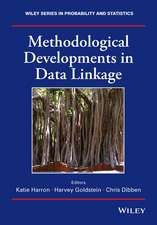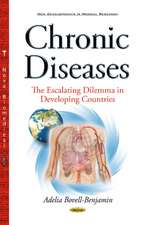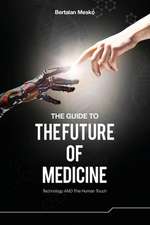The Neuroendocrine Leydig Cells and their Stem Cell Progenitors, the Pericytes: Advances in Anatomy, Embryology and Cell Biology, cartea 205
Autor Michail S. Davidoff, Ralf Middendorff, D. Müller, Adolf F. Holsteinen Limba Engleză Paperback – 22 iun 2009
Din seria Advances in Anatomy, Embryology and Cell Biology
- 5%
 Preț: 1146.33 lei
Preț: 1146.33 lei - 5%
 Preț: 721.19 lei
Preț: 721.19 lei - 15%
 Preț: 637.13 lei
Preț: 637.13 lei -
 Preț: 381.81 lei
Preț: 381.81 lei - 15%
 Preț: 644.95 lei
Preț: 644.95 lei - 5%
 Preț: 1025.16 lei
Preț: 1025.16 lei - 15%
 Preț: 689.97 lei
Preț: 689.97 lei - 15%
 Preț: 577.07 lei
Preț: 577.07 lei - 15%
 Preț: 580.36 lei
Preț: 580.36 lei - 5%
 Preț: 393.51 lei
Preț: 393.51 lei -
 Preț: 408.66 lei
Preț: 408.66 lei -
![Die Schlüpfdrüse der Geburtshelferkröte (Alytes o. obstetricans [LAURENTI]) und anderer Froschlurche](https://i4.books-express.ro/bs/9783662239742/die-schluepfdruese-der-geburtshelferkroete-alytes-o-obstetricans-laurenti-und-anderer-froschlurche.jpg) Preț: 408.27 lei
Preț: 408.27 lei - 5%
 Preț: 1090.61 lei
Preț: 1090.61 lei - 5%
 Preț: 705.11 lei
Preț: 705.11 lei - 5%
 Preț: 706.04 lei
Preț: 706.04 lei - 5%
 Preț: 357.61 lei
Preț: 357.61 lei - 5%
 Preț: 704.59 lei
Preț: 704.59 lei - 5%
 Preț: 705.11 lei
Preț: 705.11 lei - 5%
 Preț: 359.42 lei
Preț: 359.42 lei - 5%
 Preț: 711.52 lei
Preț: 711.52 lei - 15%
 Preț: 635.47 lei
Preț: 635.47 lei - 15%
 Preț: 631.72 lei
Preț: 631.72 lei - 15%
 Preț: 633.35 lei
Preț: 633.35 lei - 15%
 Preț: 632.37 lei
Preț: 632.37 lei - 5%
 Preț: 706.60 lei
Preț: 706.60 lei - 15%
 Preț: 631.07 lei
Preț: 631.07 lei - 5%
 Preț: 707.13 lei
Preț: 707.13 lei - 5%
 Preț: 707.33 lei
Preț: 707.33 lei - 5%
 Preț: 359.60 lei
Preț: 359.60 lei - 5%
 Preț: 707.69 lei
Preț: 707.69 lei - 5%
 Preț: 707.13 lei
Preț: 707.13 lei - 5%
 Preț: 708.06 lei
Preț: 708.06 lei - 5%
 Preț: 706.41 lei
Preț: 706.41 lei - 5%
 Preț: 708.78 lei
Preț: 708.78 lei - 5%
 Preț: 705.68 lei
Preț: 705.68 lei - 5%
 Preț: 705.11 lei
Preț: 705.11 lei - 5%
 Preț: 706.77 lei
Preț: 706.77 lei - 15%
 Preț: 635.15 lei
Preț: 635.15 lei - 15%
 Preț: 631.07 lei
Preț: 631.07 lei - 5%
 Preț: 706.77 lei
Preț: 706.77 lei - 5%
 Preț: 706.04 lei
Preț: 706.04 lei - 5%
 Preț: 710.79 lei
Preț: 710.79 lei - 5%
 Preț: 705.32 lei
Preț: 705.32 lei - 15%
 Preț: 633.19 lei
Preț: 633.19 lei - 15%
 Preț: 629.09 lei
Preț: 629.09 lei - 15%
 Preț: 633.53 lei
Preț: 633.53 lei - 15%
 Preț: 632.70 lei
Preț: 632.70 lei - 15%
 Preț: 633.68 lei
Preț: 633.68 lei - 18%
 Preț: 773.72 lei
Preț: 773.72 lei - 15%
 Preț: 630.43 lei
Preț: 630.43 lei
Preț: 1408.43 lei
Preț vechi: 1482.56 lei
-5% Nou
Puncte Express: 2113
Preț estimativ în valută:
269.53€ • 292.68$ • 226.41£
269.53€ • 292.68$ • 226.41£
Carte tipărită la comandă
Livrare economică 22 aprilie-06 mai
Preluare comenzi: 021 569.72.76
Specificații
ISBN-13: 9783642005121
ISBN-10: 3642005128
Pagini: 168
Ilustrații: X, 154 p. 22 illus., 2 illus. in color.
Dimensiuni: 155 x 235 x 9 mm
Greutate: 0.39 kg
Ediția:2009
Editura: Springer Berlin, Heidelberg
Colecția Springer
Seria Advances in Anatomy, Embryology and Cell Biology
Locul publicării:Berlin, Heidelberg, Germany
ISBN-10: 3642005128
Pagini: 168
Ilustrații: X, 154 p. 22 illus., 2 illus. in color.
Dimensiuni: 155 x 235 x 9 mm
Greutate: 0.39 kg
Ediția:2009
Editura: Springer Berlin, Heidelberg
Colecția Springer
Seria Advances in Anatomy, Embryology and Cell Biology
Locul publicării:Berlin, Heidelberg, Germany
Public țintă
ResearchCuprins
History of and Recent Progress in Leydig Cell Research.- Morphology of the Leydig Cells.- The Well-Known Endocrine Function of the Leydig Cells.- The Neuroendocrine Properties of the Leydig Cells.- Development of the Testis.- Development of the Neuroendocrine Leydig Cells.- Fetal and Adult Leydig Cells Are of Common Orig.- Concluding Remarks.
Textul de pe ultima copertă
The Leydig cells of the testis represent the main source of androgens. The idea of Leydig cells as endocrine cells has been the leading characteristic of this interesting cell population till now. Our studies of the last 2 decades allowed us to reveal a new important feature of Leydig cells that is their obvious similarity with structures of the central and peripheral nervous system. This includes the expression of neurohormones, neurotransmitters, neuropeptides and glial cell antigens. In this way, it became evident that in addition to the well established control by steroids and systemic hormones, important local auto- and paracrine control mechanisms of testicular functions exist.
Thus, the Leydig cells represent a specialized cell population with both endocrine and neuroendocrine properties. The discovery of the neuroendocrine features of Leydig cells gave rise to the hypothesis of a potential neuroectodermal and/or neural crest origin of testicular Leydig cells. In an experimental animal model we revealed that adult Leydig cells originate by transdifferentiation from stem/progenitor cells (pericytes and smooth muscle cells), underlying the close relationship of Leydig cells with testis microvasculature. This and the supporting data from the literature provided the basis for revealing the pericytes as a common adult stem cell type of mammalian species. Distributed by the microvasculature through the entire body, the pericyte, acting as a resting early pluripotent adult stem cell, provides an ingenious system to assure the maintenance, physiological repair and regeneration of organs, each under the influence of specific local environmental factors.
Thus, the Leydig cells represent a specialized cell population with both endocrine and neuroendocrine properties. The discovery of the neuroendocrine features of Leydig cells gave rise to the hypothesis of a potential neuroectodermal and/or neural crest origin of testicular Leydig cells. In an experimental animal model we revealed that adult Leydig cells originate by transdifferentiation from stem/progenitor cells (pericytes and smooth muscle cells), underlying the close relationship of Leydig cells with testis microvasculature. This and the supporting data from the literature provided the basis for revealing the pericytes as a common adult stem cell type of mammalian species. Distributed by the microvasculature through the entire body, the pericyte, acting as a resting early pluripotent adult stem cell, provides an ingenious system to assure the maintenance, physiological repair and regeneration of organs, each under the influence of specific local environmental factors.















